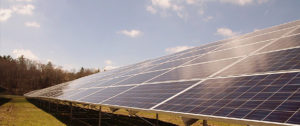Houghton’s 8,000-panel solar array made big headlines when it was built in 2015. Since construction, however, publicity has been slim. So how is is doing these days? Brian Webb, Houghton’s Sustainability Coordinator, was happy to be asked.
Attaching a hard dollar figure to the array’s performance presents some difficulties, especially given the financial and technical complexities of the system. The solar array functions through a complicated, slightly befuddling power purchase agreement, which is quickly becoming the norm in most green energy situations. Borrego Solar Systems, the solar panel manufacturer, leases college land, rents out the necessary equipment, and provides initial development funds. Since the array sits behind the main campus meter—if designed to feed directly into college dorms, it would have needed to be placed on the quad—it does not directly reduce the college’s energy consumption. Rather, electricity produced by the solar panels flows straight into the mainline, and WGL Energy retroactively applies credits for this contribution to the college’s utility bill.
Did pitching such a high-tech, eco-conscious system in conservative Allegany County present any difficulties? “Not as much as I expected,” Brian said. “Economically, it sold itself—otherwise it would have been a really hard sell. It made sense strictly from an economic perspective.” Two years later, those initial promises of economic beneficence have held out. During that time period, the solar array has netted approximately $188,000 dollars for the college. (That number represents the difference between payments to the solar company and credits from the utility provider.) Current estimates show that the solar array produces roughly 3 million kilowatt hours of electricity each year, which equates to 45% of the college’s consumption.
Over the course of the 25-year agreement, Houghton hopes to offset 50,000 metric tons of carbon emissions, save $4.3 million, and provide an attainable, affordable model for environmental sustainability to other colleges and communities. But finding ways to communicate productively about that model can be a challenge. “I think that you can’t really appreciate the situation we as a human species are in unless you realize the gravity of environmental issues,” he says. “But if you leave it at that, people feel disempowered.” His job as an environmental advocate, then, walks a delicate line between an honest appraisal of the planet’s health and a hopeful confidence in our ability to recognize and take action against those threats. Rather than drifting too far to one side or the other, Webb tries to tailor his message based to the needs and interests of his audience.
 When addressing his international development classes, for example, he focuses heavily on the impact that climate change has on impoverished and underserved populations. While speaking to evangelical Christians, he tries to frame conversations within the language of creation care, environmental stewardship, and the Biblical mandate to care for the earth. This was the strategy and ethic that influenced him to invite Katharine Hayhoe, who spoke from a distinctively Christian perspective about climate change. It also played heavily into his decision to organize the upcoming Republicans and the Climate event, which hosts conservative Rep. Bob Inglis, a prominent advocate for market-based solutions to environmental concerns.
When addressing his international development classes, for example, he focuses heavily on the impact that climate change has on impoverished and underserved populations. While speaking to evangelical Christians, he tries to frame conversations within the language of creation care, environmental stewardship, and the Biblical mandate to care for the earth. This was the strategy and ethic that influenced him to invite Katharine Hayhoe, who spoke from a distinctively Christian perspective about climate change. It also played heavily into his decision to organize the upcoming Republicans and the Climate event, which hosts conservative Rep. Bob Inglis, a prominent advocate for market-based solutions to environmental concerns.
Despite a tumultuous rhetorical climate surrounding environmental issues, Webb remains optimistic about our ability to effect change. As the solar project shows, “It’s not like we don’t have the technology. The only thing lacking is the political will.” To Webb, the economic, middle-of-the-road solution advocated by Inglis—and realized in the solar array—just might be the best answer to our century’s most pressing environmental questions. “It’s the best compromise between the idealistic and the realistic,” he said. And when so much is at stake, striking a compromise might be the most vital thing to do.
